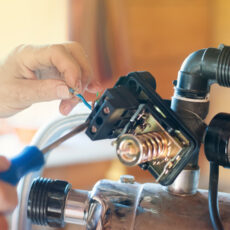 Hydraulic pump and motor systems are crucial components in a wide range of industrial applications, from manufacturing and construction to agriculture and automotive. Proper installation and maintenance of these systems are key to ensuring optimal performance and longevity. In this blog, we will discuss best practices for the installation of hydraulic pumps and motors, including considerations for system design, installation techniques, and maintenance strategies to enhance performance and efficiency.
Hydraulic pump and motor systems are crucial components in a wide range of industrial applications, from manufacturing and construction to agriculture and automotive. Proper installation and maintenance of these systems are key to ensuring optimal performance and longevity. In this blog, we will discuss best practices for the installation of hydraulic pumps and motors, including considerations for system design, installation techniques, and maintenance strategies to enhance performance and efficiency.
Selecting the Right Pump and Motor for the Application
The first step in ensuring optimal performance of hydraulic pump and motor systems is selecting the right components for the specific application. Consider factors such as flow rate, pressure rating, speed, and power requirements when choosing the pump and motor to ensure they are compatible with the system’s intended use. Consult with a hydraulic specialist or manufacturer to determine the best pump and motor combination for your application to achieve maximum performance and efficiency.
Proper System Design and Layout
Before installing the hydraulic pump and motor, it is essential to carefully plan the system design and layout. Consider the placement of the components, routing of hydraulic lines, and accessibility for maintenance and repairs. Ensure that the pump and motor are positioned in a way that allows for proper ventilation and cooling to prevent overheating and maintain optimal performance. Additionally, use quality hoses, fittings, and connectors to avoid leaks and ensure efficient operation of the system.
Ensure Correct Alignment and Coupling
Proper alignment and coupling of the hydraulic pump and motor are critical for smooth operation and longevity of the system. Misalignment or improper coupling can lead to premature wear, increased energy consumption, and reduced efficiency. Use precision alignment tools and techniques to ensure that the pump and motor shafts are aligned correctly and securely coupled to prevent vibration and damage during operation.
Secure Mounting and Support
When installing hydraulic pumps and motors, it is important to provide secure mounting and support to prevent unnecessary vibration, noise, and movement during operation. Use sturdy mounting brackets or bases to securely attach the components to the equipment or structure. Insulate the pump and motor from external vibrations and shocks to minimize wear and tear and maintain optimal performance over time.
Proper Installation of Hydraulic Lines and Fittings
In addition to the pump and motor installation, proper installation of hydraulic lines and fittings is essential for the overall performance and reliability of the system. Use high-quality hoses, tubes, and fittings that are rated for the pressure, temperature, and flow requirements of the system. Ensure that all connections are tight and free of leaks to prevent fluid loss and maintain system efficiency. Consider using protective covers or shields for hydraulic lines to prevent damage from external elements and contamination.
Regular Maintenance and Inspection
To ensure optimal performance and longevity of hydraulic pump and motor systems, regular maintenance and inspection are essential. Implement a preventive maintenance schedule that includes checking fluid levels, inspecting hoses and fittings for wear and leaks, monitoring system pressure and temperature, and lubricating moving parts as needed. Regularly clean and inspect the pump and motor components for signs of wear, corrosion, or damage, and address any issues promptly to prevent costly repairs and downtime.
Monitor System Performance and Efficiency
Proper installation and maintenance of hydraulic pump and motor systems are essential for optimal performance, but monitoring system performance and efficiency is equally important. Use monitoring tools such as pressure gauges, flow meters, and temperature sensors to track system metrics and identify any anomalies or inefficiencies. Analyze performance data to optimize system operation, identify potential issues early, and make adjustments as needed to ensure peak performance and efficiency of the hydraulic system.
Summary
Proper installation and maintenance of hydraulic pump and motor systems are critical for achieving optimal performance, efficiency, and longevity. By selecting the right pump and motor for the application, designing the system layout carefully, ensuring correct alignment and coupling, providing secure mounting and support, installing hydraulic lines and fittings correctly, conducting regular maintenance and inspection, and monitoring system performance and efficiency, you can maximize the performance and reliability of your hydraulic system. Following these best practices will help you achieve smooth operation, reduce downtime, and extend the lifespan of your hydraulic pump and motor system, ultimately saving time and costs in the long run.
Got Questions About Industrial Machinery? Let Us Help!
Hydraulic Power Sales, Inc. is local manufacture, distributor, and service provider of hydraulics equipment based in Cordova, California. Since 1985, we have been providing hydraulic repair services, hose assemblies, and sales to businesses throughout northern California. We manufacture hydraulic engine systems and hydraulic cylinders while supplying other hydraulic equipment. We want to be your one source for all of your hydraulic/pneumatic needs. Give us a call today!

